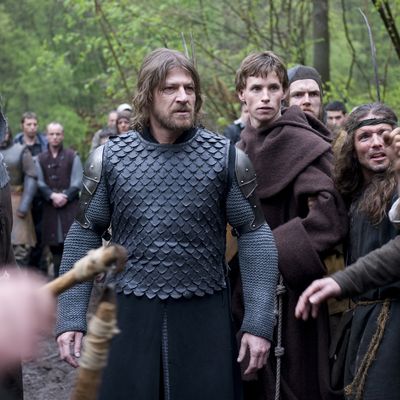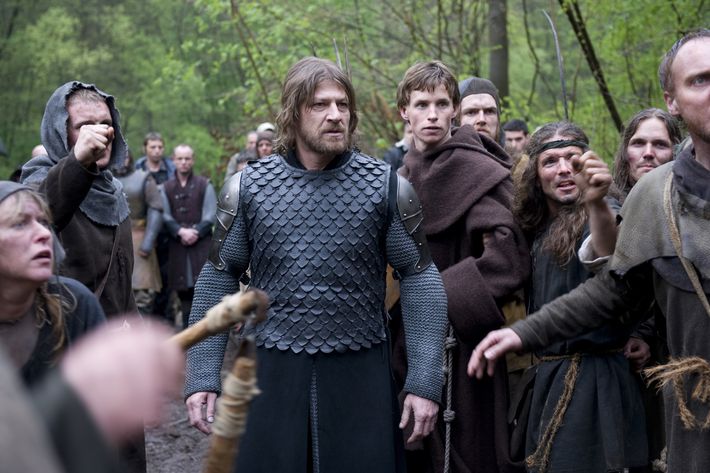

Being inherently (though, from an ironic distance, entertainingly) cruel, the English have made a specialty of witch-hunting movies. ItÔÇÖs the old revenge-of-the-repressed motif ÔÇö but with the sadism a little too insistent for comfort. The English turn out films in which monks drive giant stakes into buxom women whoÔÇÖve been carnally liberated by vampirism (Dracula, Prince of Darkness) and films in which genuine historical inquisitors like Matthew Hopkins torture nonconformists (especially female) with relish (Witchfinder General). Some English artists parody this cultural yen for punishment (Monty Python and the Holy Grail), while others explore/exploit it in the form of puritanical rage against modern promiscuity, as in Peter WalkerÔÇÖs films of the seventies. Now, in Black Death, Christopher Smith has made the most double-edged witch-hunting film of all, a grimly brutal Middle Ages number that says, quite literally, ÔÇ£a plague on both your houses.ÔÇØ
As the title would suggest, the plague ÔÇö bubonic ÔÇö features prominently. The time is 1348, when a holy-warrior band of Christian witch hunters, each man with his specialty, sets out for a remote village of sinners rumored to be overseen by a true ÔÇ£necromancer.ÔÇØ They are joined on their mission by our protagonist, Osmund (Eddie Redmayne), a monk-in-training who has sinned in his own eyes by making the beast with two backs with a comely blonde ÔÇö who has decamped for her own village, not far from where the crusaders are headed. Osmund only tags along to escape his monastery and meet up with her but inevitably becomes a player in this bloody drama.
The early scenes are fractured, the pulse of the story feeble. But Christopher Smith (working from a screenplay by Dario Poloni) has plenty of juicy atrocities up his sleeve. The chief witch hunter, Ulric (Sean Bean), is compassionate enough to kill (instantaneously, with a dagger through the armpit) a woman about to be burned alive by villagers whoÔÇÖve already made up their minds she must die. Horrible as it is, itÔÇÖs a mercy killing, and the sequence is shocking enough to dispel the Monty Python vibe ÔÇö an inevitable hazard of postÔÇôHoly Grail Middle Age pictures. But Ulric would kill the necromancer without hesitation. When the crusaders arrive at their destination, Black Death snaps into its unsettling focus.
The village is run by Tim McInnernyÔÇÖs Hob and Carice van HoutenÔÇÖs Langiva. What a pair. McInnerny is a terrific comic actor who made his mark in the Black Adder series and had a big part in Adder vet Richard CurtisÔÇÖs Notting Hill. He also made an excellent victim in SmithÔÇÖs semi-parodic slasher pic Severance (which I had the privilege of giving a thumb-up opposite an appalled Richard Roeper on the old At the Movies). Here, his character is so smug you want to see him flayed. Van Houten is the dish from Paul VerhoevenÔÇÖs Black Book, here a blonde. They look on the visitors, who are pretending to be wandering knights, with morbid delight. No oneÔÇÖs fooling anyone. The villagers believe that God is dead and have created their own moral order ÔÇö perhaps with the aid of the supernatural. TheyÔÇÖre demented ÔÇö but so are the Christians, who have, at best, a mixed record. All I can tell you is There Will Be Blood.
I dig SmithÔÇÖs stuff, especially this film and his time-travel hack-ÔÇÿem-up Triangle. HeÔÇÖs playing with ÔÇö and testing ÔÇö well-established genre motifs, and if he hasnÔÇÖt yet transcended them, he has the potential to. Black Death has a rough period texture and wreaks havoc on your sympathies. Monks and alleged necromancers are, for all purposes, morally interchangeable, which will doubtless upset more doctrinal souls but seems to me to cut to the essence of the whole witch-hunter genre. The performances are terrifically committed, the torture mostly (thankfully) suggested, the violence on the brink of being cathartic but never quite. Black Death does what all modern horror pictures should: give you your jollies and, at the same time, set one part of yourself against the other. ItÔÇÖs a brilliantly creepy essay in nihilism.


